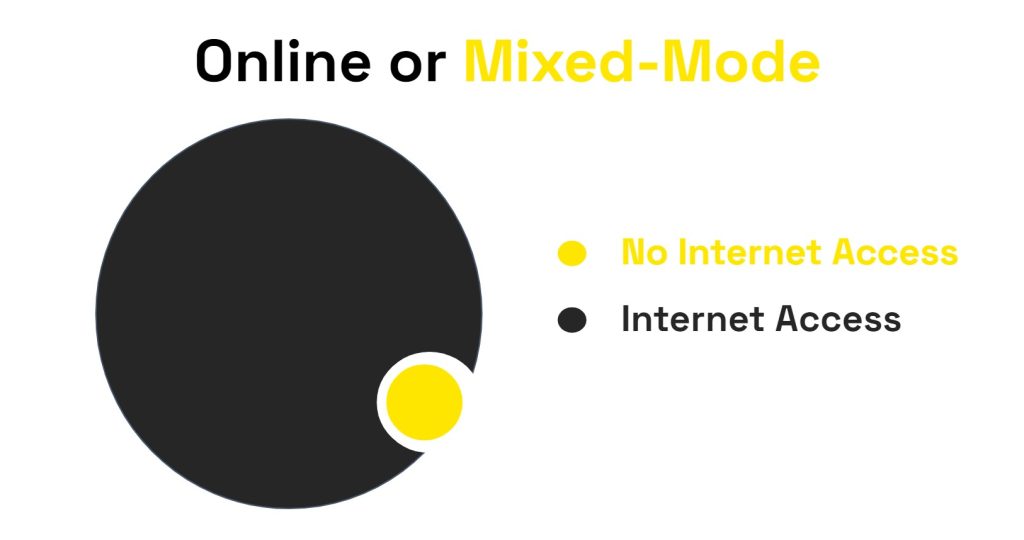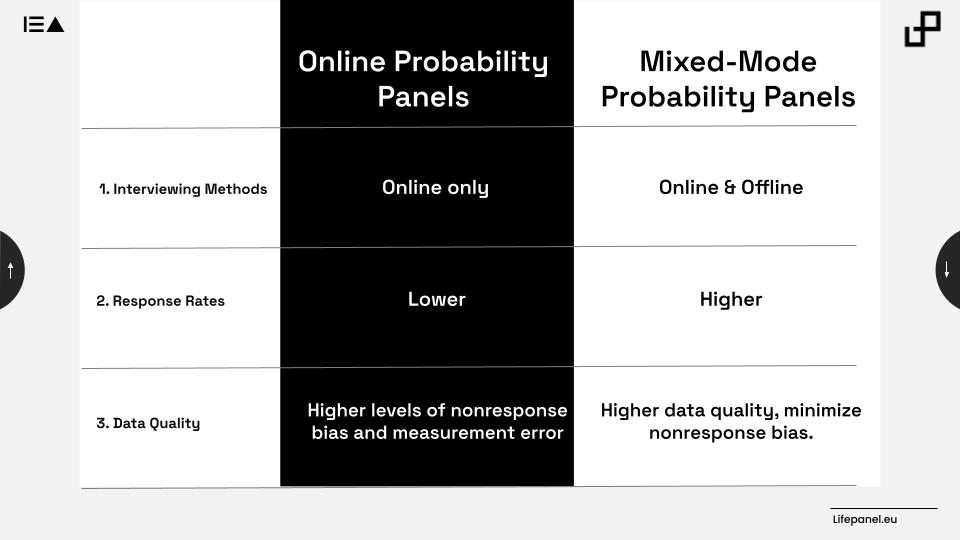TL;DR Version:
- Online panels that use traditional probability survey methods to recruit and maintain members to complete online questionnaires are called probability-based online panels.
- Mixed-mode probability panels are a popular approach to survey research because they combine different modes of data collection in a single survey and can also cover the offline population. However, they have some challenges.
- Mixed-mode surveys can be conducted additionally via phone, mail, or by tablet and offer greater coverage compared to online probability panels. They also have some disadvantages, such as the potential for mode effects and the higher cost and complexity of implementing mixed-mode designs.
- Mixed-mode probability panels mitigate selection bias, response bias, and sample retention issues by allowing for multiple modes of contact with participants.
- When choosing between online and mixed-mode probability panels, consider cost-effectiveness, flexibility, data quality, and target population.
Long Version:
Table of Contents:
Online probability panel – Definition and explanation
Differences between mixed-mode and online probability panels
Probability-based data collection methods are gaining popularity in the field of survey research. With the advent of online panels, researchers now have access to large and diverse samples at relatively low costs. Mixed-mode or full-online probability panels are a type of probability-based panel used in social science research for data collection purposes.
In this article, we will explore the different aspects of mixed-mode or full-online probability panels. Specifically, we will delve into the definition of mixed-mode surveys, the methods for probability-based online and mixed-mode panels, and the advantages and disadvantages of this type of online panel research.
According to the Social Science Computer Review, mixed-mode surveys are defined as surveys that “combine two or more modes of data collection in the same survey to maximize the strengths and minimize the weaknesses of each mode.” Probability-based online panels are panels that use traditional probability survey methods to recruit and maintain members of a panel to complete online questionnaires. There are several methods for probability-based online panels, including email invitations, telephone recruitment, and address-based sampling. These methods allow researchers to create a probability-based online panel that is diverse and representative of the population being studied.
Online panels of this kind have been around for quite some time, and we have seen several new panels start in recent years. The advantage of using these panels is that they allow researchers to collect more data at lower costs and with greater efficiency. Additionally, data collection through online questionnaires can be done more quickly than traditional survey methods.
However, there are also some disadvantages to using these panels. For instance, the response rate for online panels is often lower than that of traditional surveys, and there may be issues with data quality if respondents do not take the questionnaire seriously.
I. What are probability panels?
Probability-based panels are a statistical tool used to gather data and analyze it in a way that accurately represents the population being studied. In essence, a probability panel is a group of individuals who have been selected to participate in a study based on their likelihood of being representative of the larger population.
The process of creating a probability panel in social science begins with identifying the population to be studied. Once the population has been identified, a sample is taken from that population. This sample is selected using a random sampling method, which ensures that each member of the population has an equal chance of being selected for the sample.
From this sample, a probability panel is created by selecting only those individuals who meet certain criteria. These criteria might include age, gender, income level, or any other characteristic that is relevant to the study being conducted. The goal is to create a panel that is as representative as possible of the larger population so that any data collected from this panel can be extrapolated to make accurate predictions about the population as a whole.
Once the probability panel has been established, data can be collected through survey interviews. This data can then be analyzed using statistical techniques to draw conclusions about the larger population.
In this article, we look at two different options for probability panels: Full online probability panels and mixed-mode probability panels which both come with a set of advantages and disadvantages.
With Lifepanel we provide clients the options for both methods of sampling.
Get in contact with us, to learn which methodology suits you best.
II. Mixed-mode probability panel
In this section, we will provide an overview of what Mixed-mode probability panels are and look at some of the advantages and disadvantages of mixed-mode probability panels.
Definition and explanation
Mixed-mode probability panels refer to a type of survey research methodology that involves combining different modes of data collection in a single survey. In this approach, respondents are selected using probability sampling techniques and are then offered the option to complete the survey using different modes, such as online, phone, or mail.
The purpose of mixed-mode probability panels is to increase coverage (by not excluding the offline population), increase response rates and reduce nonresponse bias. By offering respondents multiple ways to complete the survey, researchers can reach a wider range of participants and increase the likelihood that they will respond. Additionally, by using probability sampling techniques, researchers can ensure that the sample is representative of the target population, which helps to reduce bias in the results.

Comparing Mixed-Mode and Online Probability Panels
One of the key benefits of mixed-mode probability panels is that they allow researchers to capitalize on the strengths of different modes of data collection. For example, online surveys are often faster and more cost-effective than phone or mail surveys, while phone surveys may be better suited for collecting more detailed or complex information. By combining these modes, researchers can create a survey that is both efficient and effective.
However, there are also some challenges associated with mixed-mode probability panels. For example, respondents may have different preferences for how they want to complete the survey, which can introduce bias in the results. Additionally, managing multiple modes of data collection can be complex and time-consuming for researchers.
Despite these challenges, mixed-mode probability panels have become a pioneering approach to survey research in recent years. As technology continues to evolve and new modes of data collection become available, it is likely that this approach will continue to gain traction as a way to improve the quality and accuracy of survey data.
Looking at probability panels, mixed-mode surveys can include respondents as well that do not have access to the Internet. The respondents can still be surveyed via phone, mail, or by a tablet that is provided to them.
Within Lifepanel we provide the option for researchers to survey landline phone numbers via CATI to still cover part of the population that does not have access to the internet.
Advantages
Mixed-mode probability panels have been gaining popularity among researchers due to their numerous advantages over online probability panels. In this article, we will discuss the advantages of mixed-mode probability panels and why they are preferred over online probability panels.
Firstly, mixed-mode probability panels provide a higher response rate compared to online probability panels. This is because mixed-mode panels offer multiple modes of data collection, such as phone interviews, mail surveys, and face-to-face interviews, which can increase the chances of reaching potential respondents who may not have access to or prefer online surveys. By providing multiple modes of data collection, researchers can ensure that they are reaching a diverse group of respondents and maximize their response rate.
Secondly, mixed-mode probability panels offer greater representativeness than online probability panels. Online surveys tend to attract a younger and more tech-savvy population, which can lead to biases in the sample. On the other hand, mixed-mode probability panels provide a more diverse sample by including respondents who may not have access to or prefer online surveys. This can lead to a more accurate representation of the general population.
Thirdly, mixed-mode probability panels allow for greater flexibility in survey design. Researchers can tailor their survey design to the mode of data collection they are using. For example, phone interviews may be better suited for longer surveys while online surveys may be better suited for shorter surveys. By using multiple modes of data collection, researchers can ensure that they are collecting high-quality data that meet their research objectives.
Lastly, mixed-mode probability panels offer cost savings compared to online probability panels. While online surveys may seem cheaper at first glance, they often require larger sample sizes to achieve the same level of representativeness as mixed-mode surveys. This can result in higher costs in the long run. Mixed-mode surveys offer a more cost-effective solution by providing a more representative sample with a smaller sample size.
Disadvantages
While mixed-mode probability panels offer some advantages, such as increased sample sizes and reduced nonresponse bias, there are also some disadvantages compared to online probability panels.
One major disadvantage is the potential for mode effects, where the mode of data collection can influence responses. For example, respondents may provide different answers to questions depending on whether they are completing a survey online or over the phone. This can introduce bias into the results and make it difficult to compare findings across modes.
Another disadvantage is the higher cost and complexity of implementing mixed-mode designs. It requires additional resources and coordination to manage multiple modes of data collection, which can increase costs and decrease efficiency.
In addition, mixed-mode designs may not be feasible for all research studies or populations. Some groups may be less likely to participate in certain modes of data collection, which can lead to selection bias and limit the generalizability of the findings.
III. Online probability panel – Definition and explanation
Online probability panels are a type of online survey sampling method that aims to recruit participants from a known population with a certain probability of selection. This method uses a combination of random sampling and screening questions to ensure that the participants in the panel are representative of the target population. The goal is to obtain a sample that is more accurate and reliable than non-probability samples, such as convenience samples or opt-in panels. Online probability panels are commonly used in market research, political polling, and academic research. In this section, we will compare online probability panels with mixed-mode panels.
For the case of Lifepanel, we can offer both options: a full online probability panel or a mixed-mode panel.
Advantages
Online probability panels have several advantages over mixed-mode probability panels. Firstly, they are more cost-effective as they do not require the same level of resources as mixed-mode panels due to full online questionnaires. This is because online panels can be easily accessed and managed remotely, whereas mixed-mode panels require physical resources such as phone lines, call centers, and mailings.
Secondly, online probability panels have higher response rates than mixed-mode panels. This is because online surveys are more convenient for respondents to complete, as they can be completed at any time and from any location. Mixed-mode surveys often require respondents to take multiple steps to complete the survey, which can lead to lower response rates.
Finally, online probability-based panels have the advantage of being able to collect data in real time. This means that researchers can analyze data as it is collected, which allows for more timely decision-making and faster results especially helpful in a panel study.
Overall, while mixed-mode probability panels may have some advantages in certain situations, online probability panels offer several key benefits that make them a more attractive option for many researchers.
Disadvantages
Online probability panels have become increasingly popular in recent years due to their convenience and cost-effectiveness thanks to an all-online mode compared to mixed modes. However, they do come with some disadvantages in a pure web survey compared to mixed-mode probability panels.
Firstly, online panels may suffer from selection bias as they only include individuals who have access to the Internet and are willing to participate in online surveys. This can lead to the underrepresentation of certain demographics, such as elderly or low-income populations, who may be less likely to have internet access or be less comfortable using technology.
Secondly, online panels may also suffer from response bias as participants may rush through surveys or provide inaccurate responses in order to receive compensation or simply complete the survey quickly.
Within Lifepanel we limit the risk of fraudulent respondents in a mixed-mode approach and full online approach by only allowing a single survey per month.
This can lead to lower data quality and less reliable results compared to mixed-mode probability panels where participants are more likely to take their time and provide thoughtful responses.
Lastly, online panels may also face issues with sample retention as participants may drop out of the panel over time or become inactive, leading to a loss of valuable data and potentially biased results. Mixed-mode probability panels, on the other hand, can mitigate this issue by allowing for multiple modes of contact with participants, such as phone or mail surveys, which can help maintain a more diverse and engaged panel.
Overall, while online probability panels offer many advantages in terms of convenience and cost-effectiveness, researchers should be aware of their limitations and consider using mixed-mode probability panels when possible to ensure more accurate and representative results.
IV. Differences between mixed-mode and online probability panels
In this section, we will compare some of the differences between mixed-mode and online probability panels.
Interviewing methods
Another important difference is the mode of data collection. Online probability panels collect data through online surveys, while mixed-mode data collection in probability panels may offer respondents the option to complete the survey online or through other modes, such as phone through a telephone interview (computer-assisted-telephone-interview), sms, or mail.
Response rates
Response rates can also vary between online and mixed-mode probability panels. Online probability panels may have lower response rates compared to mixed-mode probability panels due to the ease of ignoring online invitations or surveys, while mixed-mode probability panels may have higher response rates due to the use of multiple modes and follow-up efforts.
Data Quality
Data quality is another important consideration. Online probability panels may have higher levels of nonresponse bias and measurement error compared to mixed-mode probability panels since mixed-mode probability panels can multiple modes and efforts to collect surveys which minimizes nonresponse bias. However from a recruitment perspective, both panels operate similar (full online probability panels exclude the non-online population however).

Key differences among Online Probability Panels and Mixed-Mode Probability Panels in terms of Interviewing Methods, Response Rates, and Data Quality.
Sample Representativeness
Sample representativeness is another factor to consider when choosing between online and mixed-mode probability panels. Online probability panels may have limitations in terms of sample representativeness due excluding the non-internet users.
Cost-Effectiveness
Cost-effectiveness is also a factor to consider when choosing between online and mixed-mode probability panels. Online probability panels may be more cost-effective compared to mixed-mode probability panels due to the lower costs associated with online recruitment and data collection, while mixed-mode probability panels may require higher costs due to the use of multiple modes and follow-up efforts.
Flexibility
Flexibility is another advantage of online probability panels, as they offer more flexibility in terms of timing and convenience for participants. They can complete the survey at their own pace and from any location, while mixed-mode probability panels may have more restrictions in terms of scheduling and location due to the use of different modes.
Data analysis
Finally, data analysis may require different approaches depending on the type of probability panel used. Online probability panels may require different analytical approaches compared to mixed-mode probability panels due to potential differences in sample characteristics and data quality, which should be taken into account when interpreting the results.

Key differences among Online Probability Panels and Mixed-Mode Probability Panels in terms of Sample Representativeness, Cost-Effectiveness, Flexibility, and Data Analysis.
Conclusion
Overall, both online probability panels and mixed-mode probability panels have their advantages and disadvantages, and the choice between them should depend on the specific research goals, budget, and target population. It is important to carefully consider all factors before making a decision.
For projects that heavily rely on the opinions of older respondents or rural areas, it might be worth considering using a mixed-mode panel approach rather than a full online-probability approach.
About Lifepanel
While Lifepanel is a full probability-based online panel, we nevertheless provide the option for clients to include non-online respondents as well.
We can do that using two approaches: We can include recruited respondents that have mentioned not having internet access but would like to become part of the panels. These members are then called via CATI to make up between 5% and 10% of the survey.
The second option is to dial 10-15% using CATI from a fresh landline RDD sample. This ensures that clients receive a higher percentage of older people and respondents that are less likely to join a panel.


